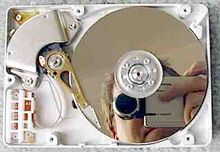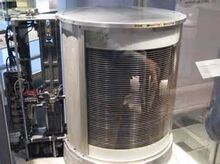by Joey Nguyen, Minion Writer
The Hard Disk Drive, often referred to as the HDD, is a part of the computer that can be found on the inside. It is used for storing and retrieving data such as applications and files, and represents the largest source of data storage in the computer. Unlike the RAM, the HDD is a non-volatile memory device.
To store data, the HDD, commonly measuring between two and four inches wide, uses a hard platter in the shape of a circle to contain the magnetic medium. It is layered onto a disk made of glass or aluminum. The HDD also contains a small device that hovers over the disk to extract data from it. The disk can turn at high speeds, up to 170 miles per hour, so the reading device can get to any point on the disk very quickly. Data is stored in sectors of tracks; a track is a ring of the disc and a sector is a part of the ring.


Files stored on the HDD are made up of bytes. When the CPU sends a request for data to be sent, the HDD locates where on the disk the data is and transmits it to the CPU, byte by byte. More expensive HDDs can locate data more quickly as well as react more quickly to requests. On the right is a picture of a typical HDD. The disc is known as the platter, and the arm on the left is what reads information. The astounding lightness and efficiency of the arm allows it to move from the mechanism on the top left to the disk and back fifty times a second. To further increase storage, modern technology has allowed us to create hard drives with multiple platters, such as the one to the right.

Unfortunately, we have not always had access to such conveniences. The IBM Ramac 350 (on right), for example, consisted of many large platters to hold several mere megabytes of data. The inefficiency of such a device prompted companies to dream up better, more effective, ways of containing data.
Sure enough, as time has gone on we have found ways to increase the efficiency of the HDD. By 1980, IBM had constructed the first hard drive capable of holding a gigabyte. By 1992, we were able to hold two gigabytes in two platters each measuring 1.3 inches. Finally, by 2006 we were able to hold 12 GB in a one-inch hard drive. In addition to larger storage, we have cut down on the size of the hard drives as well. They have gone from the size of a refrigerator to 2.5-inch disks in most laptops. Additionally, we have gained new adaptations to the hard drive constructed in 1992 such as the shock-sensing HDD.
The HDD is the most common type of hard drive and is commonly compared to the Solid State Drive (SSD), another common type of hard drive. Although the HDD is less sturdy, it is much more commonly used than the SSD because they can hold much more data for the same (or lower) cost than an SSD. However, the HDD is losing its stranglehold on the world of hard drives; we are finding new ways to optimize the efficiency of SSDs more quickly than we are with HDDs.
http://searchstorage.techtarget.com/definition/hard-disk-drive
http://www.computerhope.com/jargon/h/harddriv.htm